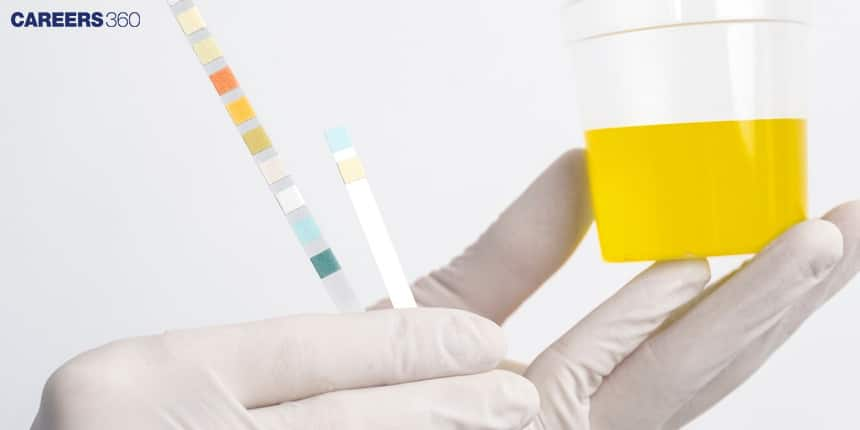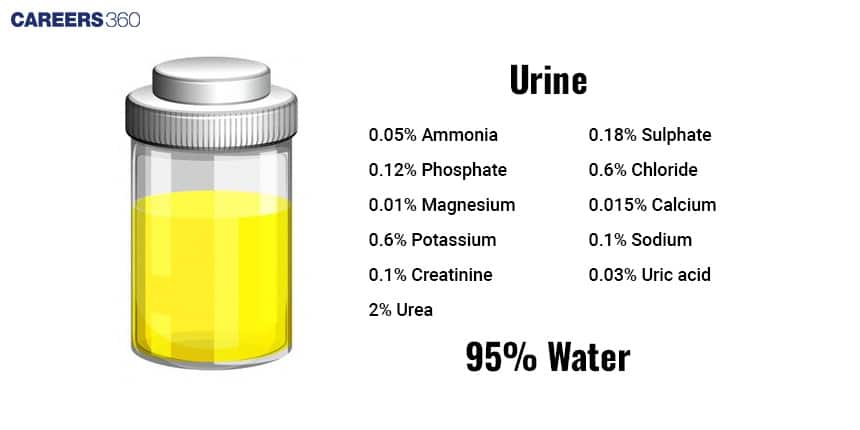Characteristics of Urine: Definition, Composition, Facts
Urine Formation
Urine is the liquid byproduct of metabolism. Its study provides much information about the health of an individual. There are three major processes involved in urine formation in the kidney: filtration, reabsorption, and secretion. All these are connected with the functional unit of the kidney, that is, the nephron.
NEET 2025: Mock Test Series | Syllabus | High Scoring Topics | PYQs
NEET Important PYQ's Subject wise: Physics | Chemistry | Biology
New: Meet Careers360 B.Tech/NEET Experts in your City | Book your Seat now
- Urine Formation
- Normal Characteristics Of Urine
- Urinalysis
- Need For Knowing The Nature Of Urine
- Recommended video on Characteristics of Urine

Normal Characteristics Of Urine

Composition Of Urine
The urine contains water, urea, creatinine, uric acid and some electrolytes like sodium, potassium, and chloride. A table on the average composition will amply bring out the constituents of the urine.
Colour Of Urine
The normal colour of urine is pale yellow to amber. The color of the urine can differ, depending on their hydration status, dietary intake, and medications currently being taken. A chart that shows the colour of the urine and its interpretation can be encouraging.
Urine Odour
The normal odour of urine is slight, or there may be no odour. The scent of the urine can change based on a diet, hydration level, and medications the patient is currently taking.
Urine pH
The pH of the urine normally ranges between 4.5 and 8. The pH of urine is influenced by differing dietary intake, medications, and certain health conditions. A graph correlating the pH levels with the potential variations in causes would be pretty helpful.
Volume Of Urine
An adult normally passes between 1.5 and 2 litres of urine each day. This volume is dependent on variables such as fluid intake, diet, and state of health.
Urinalysis
One of the diagnostic tools that is used to evaluate urine is called urinalysis. Among the tests are included dipstick, microscopic examination, and chemical analyses. Every doctor, therefore, should have the skills to perform a urinalysis and interpret its results.
Need For Knowing The Nature Of Urine
Several diseases, such as diabetes, disorders related to the kidneys, and infections can be detected early due to the constituents present in nature. By the way, this is also one of the significant reasons behind health monitoring and preventive care. Examples of diseases diagnosed based on the nature and constituents of urine can be given mostly to explain them.
Conclusion
Understanding the Nature of Urine for Good Health. Generally speaking, changes in urine are indicative of some abnormal condition, and observation of this nature helps in the early detection and monitoring of health in general.
Recommended video on Characteristics of Urine
Frequently Asked Questions (FAQs)
This accounts for the retention of the fluid and dilutes the urine. The colour of the urine provides a tip regarding the hydration level or some other health-related problems. Very pale yellow-coloured urine usually indicates that enough water is taken, whereas a reddish or pinkish colour to the urine may indicate that there may be blood in the urine.
Some foods like asparagus and coffee will change the smell of your urine. High-protein diets also make the urine smell more due to extra urea.
The necessity of always having to check the pH of urine is that constant high or low pH might be a sign of the very existence of kidney stones or some metabolic disorder.
Abnormal urine volume? A: Some of the reasons for the abnormal volume of urine include the level of hydration, health states such as diabetes, and the impact of certain medications.
Dipstick tests are conducted on the sample urine, followed by microscopic examinations and then chemical analyses. It can involve identification from infections to kidney disease and diabetes.
Also Read
28 Nov'24 08:16 PM
28 Nov'24 06:24 PM
28 Nov'24 12:06 PM
27 Nov'24 04:33 PM
27 Nov'24 02:40 PM
27 Nov'24 12:24 PM

